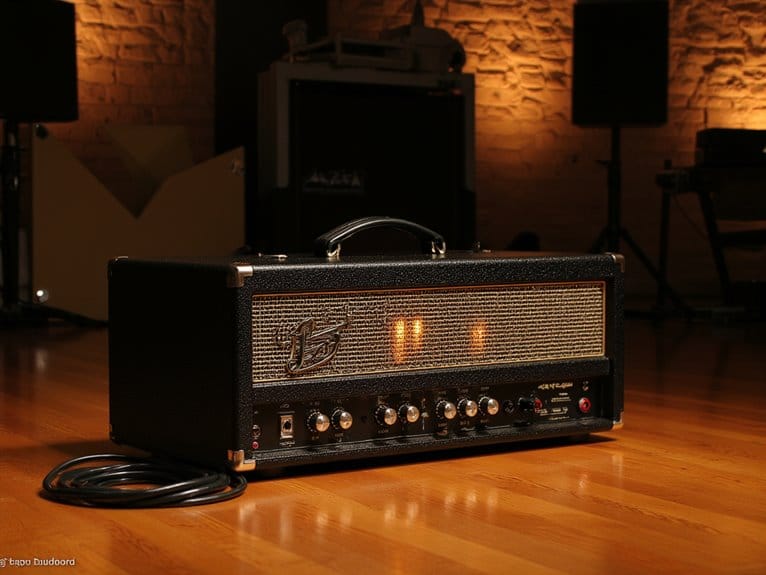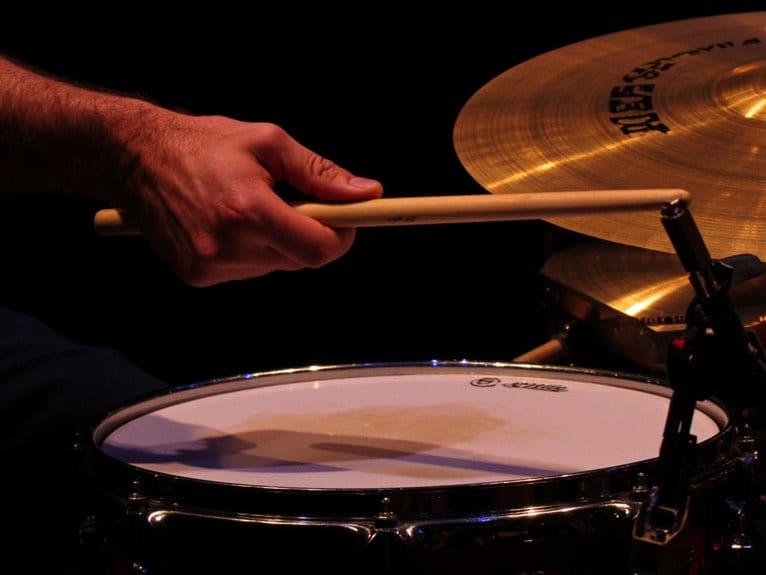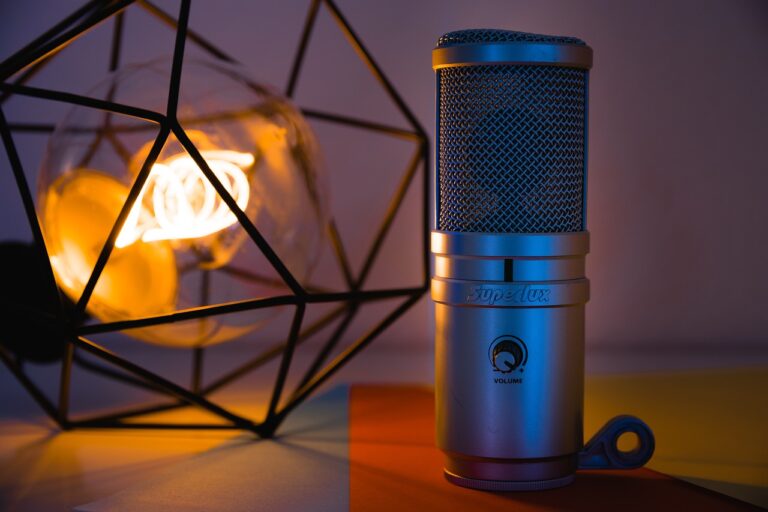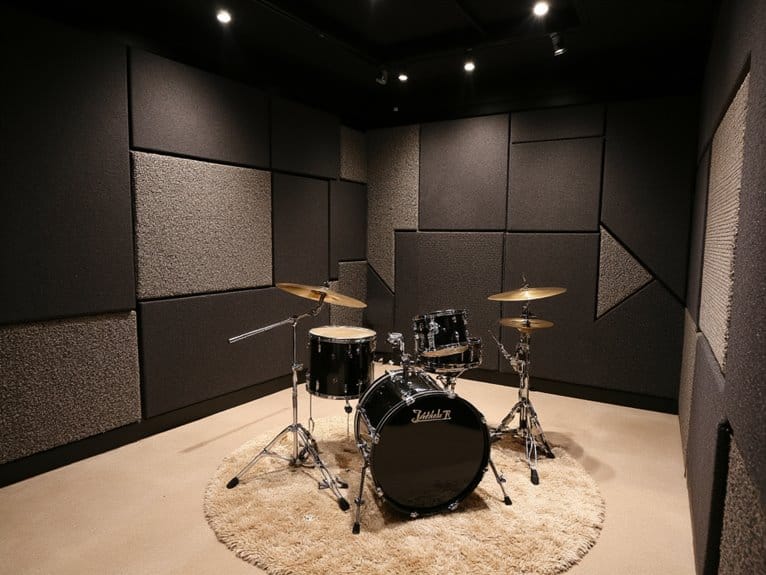Guitar Amplifiers for Home Studio Recording
For home studio recording, you’ll want amplifiers in the 15-40 watt range that deliver professional tone without overwhelming your space. Tube amps like 30-watt models provide natural overdrive and warmth, while solid-state options like the Boss Katana 100 Gen 3 offer reliable clean tones with built-in effects. Look for essential features including headphone outputs, USB connectivity for direct recording, and 3-band EQ controls for precise tonal shaping. Proper microphone placement and audio interface integration will maximize your recording quality and reveal even more sophisticated techniques.
We are supported by our audience. When you purchase through links on our site, we may earn an affiliate commission, at no extra cost for you. Learn more.
Notable Insights
- Choose 15-40 watt tube or hybrid amplifiers for authentic saturation tones at manageable volumes in home studios.
- Prioritize amps with headphone outputs, line outs, and USB interfaces for silent practice and direct recording capabilities.
- Position microphones roughly half a meter from speaker cones, using off-axis angles to reduce harshness when recording.
- Select combo configurations with 10-12 inch speakers for space-saving setups that balance clarity and warmth effectively.
- Consider modeling amplifiers for versatile tone access, offering hundreds of amp simulations and built-in effects digitally.
Types of Amplifiers Best Suited for Home Recording
When you’re setting up a home studio, choosing the right amplifier becomes a delicate balance between achieving professional-quality tones and maintaining neighborhood-friendly volume levels.
I’ve found that tube amplifiers, particularly lower-wattage models between 15-30 watts, offer exceptional tonal dynamics with their natural overdrive characteristics, though they require moderate volume to saturate effectively. The types of tubes used in these amplifiers significantly contribute to their distinctive sonic character and overall uniqueness.
Solid-state amps provide consistent, clean output with impressive reliability, while hybrid amplifiers cleverly combine tube preamp warmth with solid-state power efficiency. Like quality headphones that require high sensitivity ratings to perform well at low volumes, guitar amplifiers need efficient speakers and well-designed circuits to deliver rich tones without excessive volume levels.
Hybrid amplifiers deliver the best of both worlds: tube warmth in the preamp section with solid-state reliability and efficiency.
Modeling amplifiers excel in amp versatility, delivering multiple classic tones through digital processing alongside direct recording capabilities via USB connectivity. Advanced profiling technology allows these digital amps to capture and replicate the exact characteristics of your favorite tube amplifiers with remarkable accuracy.
For most home studios, combo configurations prove most practical, integrating amplifier circuitry and speakers into space-saving units that won’t overwhelm smaller recording environments. Many modern combo amps feature cab-sim outputs that allow for silent practice and direct recording to your audio interface without disturbing others.
Top Amplifier Recommendations for Home Studios
When you’re ready to select your home studio amplifier, I’ve found that the choice typically comes down to three main categories, each offering distinct advantages for recording applications.
Tube amplifiers provide that coveted warmth and natural compression that’s made them studio staples for decades, while solid-state options deliver consistent performance and often include convenient recording features like USB connectivity.
Modeling amplifiers have revolutionized home recording by packing hundreds of amp simulations into a single unit, giving you access to virtually any tone you can imagine without the space requirements or volume constraints of traditional setups. Higher wattage amplifiers in this category also provide cleaner and more defined tones that can better cut through complex mixes during recording sessions.
For home studio applications, hybrid designs combine tube preamp sections with solid-state output stages, delivering the tonal richness of tubes while maintaining the reliability and consistent performance needed for recording sessions.
Solid-State Amp Choices
Several exceptional solid-state amplifiers stand out as premier choices for home studio recording, each offering distinct advantages that cater to different musical styles and recording requirements.
The Mesa/Boogie Mark Five solid-state equivalent delivers unmatched versatility with nine unique tones across three channels, while its built-in 5-band EQ excels at controlling dynamics from sparkling cleans to crushing overdrive.
Roland’s JC-120 Jazz Chorus remains legendary for pristine clean tones, though its 120-watt power and substantial weight make it better suited for larger spaces.
The Boss Katana 100 Gen 3 strikes an ideal balance, offering excellent internal effects, line-out connectivity, and organic tonal nuances that maximize solid state advantages without compromising your budget or studio space requirements. Professional recording quality can be achieved with 24-bit/192 kHz audio interfaces that complement these amplifiers perfectly.
For home studio recording, consider amplifiers with USB interfaces that facilitate easy recording integration, allowing seamless connection to your digital audio workstation for professional-quality recordings.
Tube Amplifier Options
Tube amplifiers remain the gold standard for home studio recording, delivering that unmistakable warmth, harmonic richness, and dynamic response that’s made them legendary among guitarists for decades. Understanding tube amplifier benefits helps you appreciate why they’re studio favorites, while recognizing tube amplifier drawbacks guarantees realistic expectations.
| Amplifier | Wattage |
|---|---|
| Blackstar HT-1R MKII | 1W |
| Fender Princeton | 12W |
| Fender Blues Junior IV | 15W |
| Hughes & Kettner Tubemeister Deluxe 20 | 20W |
| Revv G20 | 20W |
The Fender Princeton’s unchanged 1950s design delivers exceptional clean tones, while the Blues Junior IV’s three 12AX7 preamp tubes provide versatility. For high-gain recording, the Revv G20’s Two Notes Torpedo technology offers direct interface connection, and the Hughes & Kettner’s Red Box DI output optimizes recording capabilities perfectly. While tube amplifiers excel in delivering warm harmonic distortion favored by recording professionals, they do require periodic tube replacement and higher maintenance costs compared to solid-state alternatives. Modern tube amplifiers often feature headphone outputs for silent recording sessions, allowing engineers to capture the authentic tube tone without acoustic bleed in the studio environment.
Modeling Amp Features
While tube amplifiers dominated home studios for decades, modeling amps have revolutionized the recording landscape by cramming dozens of meticulously crafted amp simulations into single, space-efficient units that won’t wake your neighbors at 2 AM.
These digital powerhouses use sophisticated DSP algorithms to replicate everything from vintage Vox AC30 chime to Marshall JCM800 crunch, delivering authentic tone shaping capabilities that would otherwise require a warehouse full of expensive gear.
You’ll find built-in effects like delay, reverb, and chorus eliminate your need for external pedals, while USB connectivity streamlines your recording workflow directly into DAWs.
Popular options include Yamaha’s THR-II series for desktop convenience, Line 6’s Helix for extensive amp simulation, and Boss Katana Air for wireless flexibility, each offering intuitive interfaces that mirror traditional amp controls. The Fender Mustang LT25 stands out with its color display interface and comprehensive amp modeling options that cater to both beginners and intermediate players seeking professional-grade versatility.
For home studio applications, consider that power output typically ranges from 10-100+ watts, with 25-40 watts providing sufficient headroom for recording without overwhelming your space or requiring excessive sound treatment.
Essential Features to Look for in Home Studio Amps
When choosing a guitar amplifier for your home studio, understanding which features matter most can save you from expensive mistakes and buyer’s remorse down the road. Start by considering amp wattage, as lower-powered units between 5-20 watts provide better natural overdrive at manageable volumes, while high-wattage amps often overwhelm home spaces.
The preamp tone controls become essential for shaping your sound, with gain, EQ, and presence knobs allowing precise tonal adjustments across genres. Look for headphone outputs and line outs for silent practice and direct recording capabilities. 3-band EQ controls provide comprehensive tone shaping across different frequency ranges for more precise sound customization.
Built-in effects like reverb and delay reduce pedal clutter, though quality varies greatly between manufacturers. Modern amplifiers with USB audio interfaces streamline the recording process by eliminating the need for additional hardware when connecting directly to your computer. Finally, prioritize compact designs that balance portability with adequate speaker size for your recording needs.
Recording Techniques and Considerations for Home Use
When you’re recording guitar amps in your home studio, the positioning of your microphone becomes absolutely critical to capturing the tone you’re after, whether that’s placing it directly in front of the speaker cone for aggressive detail or angling it slightly off-axis to tame harsh frequencies.
You’ll also need to master volume control methods that let you achieve great recorded tones without angering neighbors or family members, since cranked tube amps at 2 AM rarely end well for anyone involved.
These two fundamental techniques work together to help you capture professional-sounding guitar tracks while respecting the practical limitations that come with recording in residential spaces.
Connecting your amplifier through an audio interface ensures you can achieve 24-bit/192kHz recording quality while maintaining zero-latency monitoring for precise performance timing.
For optimal recording quality, consider using microphones with noise cancellation features to minimize room reflections and unwanted ambient sounds that can muddy your guitar recordings in untreated home environments.
Microphone Placement Strategies
The golden sweet spot for your microphone sits roughly half a meter from your amplifier’s speaker cone, where you’ll capture that perfect balance of direct amp tone and natural room character that makes home recordings shine.
Adjusting your mic angle slightly off-axis reduces harshness while capturing varied frequencies, and the proximity effect in dynamic mics adds warmth when positioned closer.
Speaker identification becomes essential—use a flashlight to locate cone edges precisely, since center placement delivers brightness while off-center yields warmer tones. Studio-quality headphones with flat frequency response help you accurately monitor these subtle tonal differences during the recording process.
Multiple mics offer expanded tonal options, with front-facing and rear-facing configurations capturing different frequency ranges, though you’ll need careful phase alignment to prevent cancellation issues that can muddy your recordings.
Professional recording setups benefit from zero-latency monitoring capabilities that allow you to hear your guitar performance in real-time without the delay that can disrupt your playing timing and feel.
Volume Control Methods
Managing volume effectively becomes the cornerstone of successful home studio recording, since you’ll need to balance authentic amp tone with practical noise constraints that won’t irritate neighbors or family members.
Finding your amp’s tonal sweet spot while maintaining reasonable volume levels requires strategic approaches that preserve the harmonic richness and dynamic response you’re after.
Here are four essential volume control methods I’ve found most effective:
- Power soaks and attenuators – Insert between amp and speaker to achieve cranked-amp tone at manageable volumes
- Strategic gain staging – Set interface levels around -18 to -12 dB while pushing amp volume to healthy saturation points
- Guitar volume manipulation – Use your instrument’s volume knob for tonal variance and dynamic expression during recording
- DI recording with amp simulation – Capture clean signal for later processing when acoustic volume becomes completely impractical
For home studios where neighbor-friendly volume is essential, 5-watt tube amps offer authentic tube tone and natural overdrive at manageable volumes while maintaining the harmonic complexity needed for professional recordings.
Consider pairing your guitar amp with an affordable audio interface that offers professional-grade preamps and zero-latency monitoring capabilities to capture every nuance of your performance without breaking the budget.
Audio Interface Integration for Guitar Recording
Setting up your guitar with an audio interface opens doors to professional-quality home recording, though it’s not quite as simple as plugging in and hitting record.
Your Hi Z setup requires engaging that instrument input’s impedance switch, which prevents your guitar’s signal from sounding like it’s underwater.
I’ve learned that dual recording—capturing both your direct signal and a miked amp simultaneously—gives you incredible flexibility during mixing, letting you blend clean and processed tones or completely replace them later.
Most interfaces bundle amp simulation software that transforms lifeless direct recordings into convincing amplified sounds.
Direct monitoring eliminates frustrating latency issues, while proper gain staging between your guitar and interface prevents digital clipping that’ll ruin otherwise perfect takes.
Look for interfaces with 24-bit/192kHz resolution to capture the full detail and nuance of your guitar’s tone with professional clarity.
Professional interfaces feature zero-latency monitoring through dedicated headphone outputs to maintain perfect timing during recording sessions.
Practical Selection Guide for Your Home Studio Setup
When choosing your home studio amplifier, you’ll discover that the perfect amp balances three critical factors: tonal quality that captures your musical vision, manageable volume levels that won’t anger neighbors, and practical features that streamline your recording workflow.
These amp selection tips will guide your decision-making process while considering studio acoustics:
Strategic amp selection requires balancing tonal preferences with acoustic limitations to achieve professional home studio results.
- Prioritize 15-40 watt tube or hybrid amplifiers that deliver cranked saturation tones at reasonable volumes, allowing harmonic richness without excessive loudness in untreated rooms.
- Select combo units with 10-12 inch speakers like Celestion A-Types, which provide balanced clarity and warmth while maintaining compact footprints for smaller spaces.
- Ensure extensive connectivity options including USB outputs and Bluetooth capabilities for direct recording integration with digital audio workstations.
- Invest in built-in effects and multi-band EQ controls that expand tonal versatility when external processing gear isn’t available.
Frequently Asked Questions
Can I Use Guitar Amp Simulators Instead of Physical Amplifiers for Recording?
You can absolutely use guitar amp simulators instead of physical amplifiers for recording. Modern amp sims deliver excellent guitar tone and audio quality that’s often indistinguishable from real amps in final mixes.
What’s the Difference Between Recording With Microphones Versus Direct Input Methods?
You’ll capture authentic amp tone through careful microphone placement, while direct input offers convenience but requires amp simulation. Direct input needs proper input impedance matching, whereas mics provide natural sound complexity and room ambience.
Should I Buy Vintage Amplifiers or Modern Reissues for Home Recording?
You’ll find vintage tones appealing but costly and maintenance-heavy. Modern reissues offer reissue benefits like reliability, lower prices, and studio-friendly features while capturing similar sounds, making them smarter choices for consistent home recording.
How Much Should I Budget for a Complete Home Guitar Recording Setup?
You’ll need $500-$1,000 for entry-level setups or $1,000-$3,000 for mid-range quality. Your budget breakdown should prioritize essential equipment: audio interface, microphone, monitors, and DAW software before expanding to additional gear.
On a final note
You’ve got the knowledge now to choose an amplifier that’ll transform your home studio recordings from amateur to professional quality. Whether you’re tracking through a tube amp‘s warm saturation, a solid-state’s clean reliability, or a modeling amp’s versatility, the right choice depends on your specific needs, budget, and recording environment. Don’t overthink it—trust your ears, test what you can, and start recording those ideas you’ve been sitting on.







